Related Research Articles

The Caridea, commonly known as caridean shrimp or true shrimp, are an infraorder of shrimp within the order Decapoda. This infraorder contain all species of true shrimp. They are found widely around the world in both fresh and salt water. Many other animals with similar names – such as ghost shrimps, mud shrimps, and boxer shrimps – are not true shrimps, but many have evolved features similar to true shrimps.
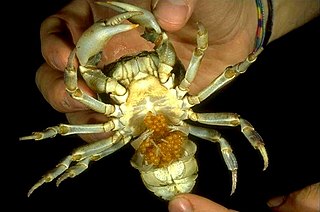
Pleocyemata is a suborder of decapod crustaceans, erected by Martin Burkenroad in 1963. Burkenroad's classification replaced the earlier sub-orders of Natantia and Reptantia with the monophyletic groups Dendrobranchiata (prawns) and Pleocyemata. Pleocyemata contains all the members of the Reptantia, as well as the Stenopodidea, and Caridea, which contains the true shrimp. Pleocyemata comprises the following infraorders:

Eucarida is a superorder of the Malacostraca, a class of the crustacean subphylum, comprising the decapods, krill, Amphionides and Angustidontida. They are characterised by having the carapace fused to all thoracic segments, and by the possession of stalked eyes.

Gnathophyllidae is a pantropical and subtropical family of shrimp in the superfamily Palaemonoidea. They are often associated with echinoderms.

Hippolytidae is a family of cleaner shrimp, also known as broken-back shrimp or anemone shrimp. The term "broken-back shrimp" also applies to the genus Hippolyte in particular and "cleaner shrimp" is sometimes applied exclusively to Lysmata amboinensis.
The family Stylodactylidae is a group of shrimp and the only representative of its superfamily (Stylodactyloidea). It contains the five genera Bathystylodactylus, Neostylodactylus, Parastylodactylus, Stylodactyloides and Stylodactylus.
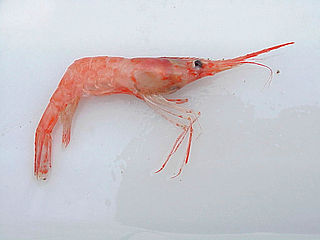
The family Pandalidae is a taxon of caridean shrimp. These species are commonly called pandalid shrimp. They are edible and have high economic value. They are characterised by the subdivided carpus of the second pereiopod and, mainly, by the lack of the chelae (claws) on the first pereiopod. This is a cold-water family, and their representation in tropical areas is made by deep-sea shrimp. The genus Physetocaris, sometimes placed in this family, is now considered to be in its own family, Physetocarididae.

Pasiphaeidae is a family of shrimp. It is the only family in the superfamily Pasiphaeoidea and contains seven extant genera:
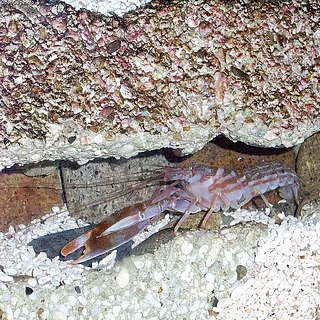
Alpheidae is a family of caridean snapping shrimp, characterized by having asymmetrical claws, the larger of which is typically capable of producing a loud snapping sound. Other common names for animals in the group are pistol shrimp or alpheid shrimp.

Palaemonidae is a family of shrimp in the order Decapoda. Many species are carnivores that eat small invertebrates, and can be found in any aquatic habitat except the deep sea. One significant genus is Macrobrachium, which contains commercially fished species. Others inhabit coral reefs, where they associate with certain invertebrates such as sponges, cnidarians, mollusks and echinoderms as cleaner shrimps, parasites, or commensals. They generally feed on detritus, though some are carnivores and hunt tiny animals.

Psalidopus is a genus of shrimp placed in its own family, Psalidopodidae, and superfamily, Psalidopodoidea. It comprises three species, one in the western Atlantic Ocean, and two in the Indo-Pacific.

Farfantepenaeus is a genus of prawns in the family Penaeidae. Its eight species were formerly included in the genus Penaeus. It was first published as a genus name in 1972 by Rudolf N. Burukovsky, but without the necessary designation of a type species. That situation was corrected by the same author in 1997. The name Farfantepenaeus commemorates the Cuban carcinologist Isabel Pérez Farfante.

The Pandaloidea are a superfamily of shrimp, comprising the large family Pandalidae and the much smaller Thalassocarididae.
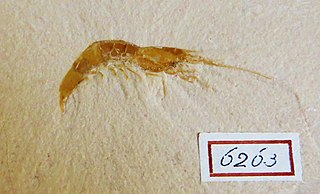
Hefriga is an extinct genus of shrimp in the order Decapoda. It contains three species, and lived in the Jurassic period.

Bresilioidea is a superfamily of shrimp. It is likely to be an artificial group, containing five families which may or may not be related.
Birulia is a genus of shrimp. It is one of a group of genera that are usually treated as part of the family Hippolytidae, but have also been separated off as the family Thoridae.
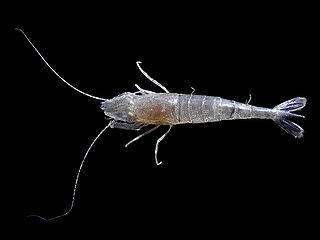
Crangonoidea is a superfamily of shrimp containing the two families Crangonidae and Glyphocrangonidae.
Campylonotoidea is a superfamily of shrimp, containing the two families Campylonotidae and Bathypalaemonellidae. Fenner A. Chace considered it to be the sister group to the much larger superfamily Palaemonoidea, with which it shares the absence of endopods on the pereiopods, and the fact that the first pereiopod is thinner than the second. Using molecular phylogenetics, Bracken et al. proposed that Campylonotoidea may be closer to Atyoidea. There are sixteen described species in 3 genera; no fossils are known.
Isabel Pérez Farfante was a Cuban-born carcinologist. She was the first Cuban woman to receive her Ph.D. from an Ivy League school. She returned to Cuba from the United States only to be blacklisted by Fidel Castro's government. She and her family escaped Cuba, and she became one of the world's foremost zoologists studying prawns. She discovered large populations of shrimp off the coast of Cuba and published one of the most noted books on shrimps: "Penaeoid and Sergestoid Shrimps and Prawns of the World. Keys and Diagnoses for the Families and Genera."
Thoridae is a family of cleaner shrimp, also known as broken-back shrimp or anemone shrimp.
References
- ↑ Sammy De Grave; N. Dean Pentcheff; Shane T. Ahyong; et al. (2009). "A classification of living and fossil genera of decapod crustaceans" (PDF). Raffles Bulletin of Zoology . Suppl. 21: 1–109.
- ↑ Raymond B. Manning & Fenner A. Chace, Jr. (1971). "Shrimps of the family Processidae from the Northwestern Atlantic Ocean (Crustacea: Decapoda: Caridea)" (PDF). Smithsonian Contributions to Zoology . 89.